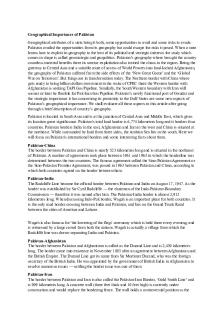101311691 Major Industries of Pakistan PDF

| Title | 101311691 Major Industries of Pakistan |
|---|---|
| Course | Accounting |
| Institution | University of Manila |
| Pages | 63 |
| File Size | 580 KB |
| File Type | |
| Total Downloads | 5 |
| Total Views | 149 |
Summary
Lecture Note in the Major Industries of Pakistan...
Description
Major Industries of Pakistan
28 May 2012
Cotton Textile Industry After the freedom of Pakistan the maximum progress was made by the industry of cotton cloth. Cotton cloth was mostly imported. Government gave much importance to this industry and encouraged. At that time 850 small and large industries were working. In 1975 the produce of cloth was 70 corer yarns. Now our country is independent in some types of cloth yards but cotton cloth is also being exported. Japan and Hong Kong are the biggest importers of our cloth. Now the import of this industry is finished. Its industries are mostly in Faisalabad, Lahore and Karachi. Faisalabad is called the Manchester of Pakistan. Two industries Bolan Textile and Lusbella are being established by the cooperation of Iran. It will cost Rs. 67 Corers.
Woolen Textile Industry There is no industry of woolen cloth in Pakistan before partition. One difficulty is that fine woolen thread has to be imported. Country wool is not so good that it can be used in the manufacturing of good quality cloth. It is mostly used in carpet making high quality woolen cloth blanket and woolen thread. In Pakistan is made in Bannu, Karachi, Lawrencepur, Hernai Multan, Noshera and Quaidabad.
Cement Industry There was only industry of cement when Pakistan came in to being. Now many industries are working in Daud Khel, Dandkot, Hyderabad, Wah, Rohrim Jhelum, Hazara and Karachi. Calcium Carbonate, Gypsum and Special clay which is used in its manufacturing is sufficient in Pakistan. A factory is being made in Spuntungy in Balochistan with the cooperation of Iran. Second factory is under construction at Gudai in Lasbella. Factories of cement are also working in Gharibwal, Farooqui, Noshera, Kohar and Nooriabad.
Sugar Industry Sugar factories are working in Mardan, Faisalabad, Joharabad, Bunny, Pattoki, Charsada, Larkana, Chorister, Tando Muhammad Khan, Bahawalpur, Jhung, Layyah, Darya Khan and Gujrat. Five factories in Punjab and three in Province of Sindh are being constructed. One factory is also being made in Frontier.
Fertilizer Industry There was no fertilizer factory in Pakistan when it came into being but now several factories are working Daud Khel, Multan and Faisalabad.
Leather Industry Animal skins are the important crude material of Pakistan. Many big factories are working in Lahore, Karachi and Hyderabad. Pakistan earns enough foreign exchange by exporting new leather and leather good. Now there are eighty factories working in Pakistan which are cleaning leather.
Paper Industry Factories of paper making have been set up in Lahore, Noshera, Charsadda and Gharo. For newspapers need a factory is working in Hyderabad and a factory has also been set up in Shakarghar.
Card Board Industry The needs of cardboard are also met through import. Now a factory in Noshera produces good quality of cardboard. A factory at Rahwali in Gujranwala is preparing cardboard.
Electric Goods Industry Pakistan has progressed much in electric industry. The factories of wire making and radio circuits are progressing T.V., radio, refrigerator and air-conditioners are also being manufactured. These factories are in Lahore, Karachi, Gujrat and Gujranwala.
Iron Industry There are some factories in Karachi and Lahore which are making pig iron from crude iron. The factory of pig iron would have been formed long ago but now it is too late. Now steel mill in Karachi is working with the cooperation of Russia.
Machine Industry A factory has been set up at Texilla with cooperation of China which prepares parts of engines, railway wagons, wheels and axles, road building machines etc.
Ship Industry Karachi Shipyard is working in karachi which is preparing small size ships. Now it is also making big ships. A factory of ship making is also being established in Bin Qasim.
Oil Refining Industry
These industries are working Rawalpindi, Multan and Karachi.
Industry of Banaspati Ghee In Pakistan the industry of banaspati ghee has progressed much but its production is less the need of our country. More factories are being set up. There was no ghee factory in Balochistan at the time of partition. But now two factories are working at Quetta and Temple Dera. In 1973 this industry was nationlized. Government is establishing more factories according to our needs. Two factories are located in Northern areas and one is being set up on tribal areas. Now there are 25 ghee factories in Pakistan.
Chemical Industries In Pakistan the industries of soda ash, colour, caustic soda, sulphuric acid, insecticides and pharmacy medicines have done much progress.
Armament Industry We are preparing Rifles, Machine Guns, Mortars and other small weapons. Pakistan is self dependent in these arms and is also exporting to other Muslim countries. At Kamra (Attock) factories are making airplanes and doing the work of their repair. Here facilities are available for repining Mirage and F-16 are also for their complete assembling. A small airplane is made at Kara to train the new pilots. Its
name is Mushaak.
Miscellaneous Industries Many other industries have also progressed much. Among them, industries of flour grinding, cigarette making, match sticks, glass making and cycle making are important.
Physical Review 2010-11
The movement in the growth of large-scale manufacturing (LSM) could not be sustained in the initial months of FY 2010-11. The LSM growth turned negative in August 2010, due to heavy rains and floods, which particularly affected construction, petroleum refining, cotton textiles, and agro-based industries. However, LSM posted growth in December and onwards despite acute energy shortages and weak textile performance. Similarly, strong domestic demand, led to robust growth in automobiles, fertilizers, rubber, and engineering industries. Moreover, strong external demand supported the growth in chemicals and leather.
It is fairly anticipated that the export-led growth in the cement sector seen in the recent past would lose some steam as competition tightened due to expansion of cement
Industry and Commerce
producing capacity in the importing countries. Some other export-based industries, including pharmaceutical and electric fans, which benefitted from geographical diversification in the past two years, lost ground in non-traditional markets. For the pharmaceutical sector, this decline came about in response to increasingly stringent quality requirements for drug exports, and growing competition from India, on the other hand, fan exports are losing to both Chinese and Indian manufacturers in destination markets.
Industry and Commerce
higher cost of production, power shortage, misaligned provision of subsidies and prevailing Security situation in the country.
During 2010-11, manufacturing sector as a whole is expected to grow at 2.6 % while large scale and small scale manufacturing will respectively grew at 1.0% and 7.5%. According to Quantum Index of Manufacturing (QIM), the positive growth during the period was contributed by Automobiles (18.2%), Electronics (2.2%), Engineering items (2.5%) and Pharmaceuticals (3.9) while the growth of Petroleum products (-4.8), and Fertilizers (-6.8%) was negative during the period. Ailing performance of industrial sector attributed to constant energy shortages. Development progress during 2010-11 is discussed as under:
Manufacturing Sector: An expenditure of Rs 946 million has been incurred during 2010-11 in the industry sector against an allocation of Rs 1,548.6 million. The major projects under taken during the year under review includes: Women Business Incubation Center Lahore, Development Projects of Pakistan Gems & Jewellery Development Co., Development of Marble and Granite Sector, Sialkot Business & Commerce Center (SBCC), Supply, Installation, Commission and Operation of 2MGD Water Desalination Plant at industrial Estate Gawadar, Sports Industries Development Center Sialkot, Glass Products Design and Manufacturing Center Hyderabad, Sindh, Construction of Boundary Wall at site office for Gwadar EPZA, Red Chilies Processing Center Kunnri, Sindh.
In Textile Rs 60.3 million has been invested during 2010-11 which have been utilized totally showing 100% utilization. The major projects include; Lahore Garment City Project, Punjab, Faisalabad Garment City Project, Punjab, 48 inch Diameter Water Pipeline for Pakistan Textile City, Extension in Export Development Plan Implementation Unit, Up-gradation of EDF Funded Textile Institutes.
Commerce Sector: An amount allocated during 2010-11 of Rs 158.6 million was fully utilized. Number of projects implemented during the 2010-11 included: Adoption of Social Accountability – 8000 (SA-8000), Islamabad, Creation of Domestic Commerce Wing in the Ministry of Commerce, Creation of Planning &Monitoring Wing in Ministry of Commerce, Purchase of Equipment, Furnishing, Curriculum Development and Training of PSFD, Lahore, Up-gradation & Additional Works of Expo Centre at Lahore, Restructuring of Pakistan Institute of Trade and Development (PITAD), Islamabad.
Outlook for 2011-12
During 2011-12, manufacturing sector would work on numerous fronts to rejuvenate its outlook through enabling policies and development projects. These projects provide demonstration effect along with opportunities for skills development, common training facilities, and technological transfer and up gradation, energy efficient environment and development of emerging sectors to achieve the goals of diversification. Specifically the core objectives of these projects are:
Innovation and efficiency.
Build high skilled human capacity through skills development.
Provide technology through technological up-gradation; provision of sophisticated machines, equipment, tools & spares in Common Facility Centers and machine pools; CAD/CAM facilities.
Research and development in key manufacturing sectors.
89
Industry and Commerce
Develop industrial infrastructure through Industrial Parks and Industrial Estates.
Promote Public Private Partnerships.
The targeted growth rate for 2011-12 has been set at 3.7% for manufacturing Sector as a whole, while 2% and 7.5 % growth rates have been fixed for large scale and small scale manufacturing respectively. The main growing industries in the year 2011-12 would be chemicals, automobile, pharmaceutical, electronics, leather products, paper & boards, and non-metallic minerals. In order to see textile growing, support industries like textile machinery manufacturing, textile dyes & chemicals and accessory industries are to be developed as most of the demand is currently met through imports. Promotion of joint ventures with leading international brands is also needed.
An allocation of Rs 2,030 million has been earmarked industry sector in the year 201112 for the Ministry of industries & Production for about 43 development projects. Major projects to be carried out in Industry Sector during 2010-11 include: Establishment of
(8) Advance CAD/CAM Training Centers (Rs 321.1 million), Ceramics Development & Training Complex (Rs 314.5 million), Development Pakistan Gem & Jewellery Development Company (Rs 1,400.0 million), Development of Marble and Granites Sector all over Pakistan (Rs 1,980.0 million), Sports Industries Development Center, Sialkot (Rs 435.64 million), Agro Food Processing Facilities Multan (Rs 288.920 million), Export Processing Zones and Area Development Baluchistan including ROZs (Rs 4,000 million) and BMRE of Heavy Mechanical Complex Taxila (Rs 23,428.2 million).
An allocation of Rs 414 million has been made for the Textile sub Sector for the year 2011-12, for the Ministry of Textile Industry. Prominent projects to be launched in the year 2011-12 include: Lahore Garment City Company (Rs 497.6 million), Faisalabad Garment City (Rs 498.8 million), providing & Laying Dedicated 48 inch Diameter Mild steel water main for Textile City (Rs 636.6 million), and Pak-Korea Garment Technology Training Institute, Karachi (Rs 300 million).
An amount of Rs 500 million has been allocated for Commerce Sector for the year 2011-12 for the Ministry of Commerce. Major projects to be initiated during 2011-12 include: Adoption of Social Accountability – 8,000 (Rs 124.89 million), Purchase of Equipment, Furnishing, Curriculum Development and Training of Pakistan School of Fashion Design, Lahore (Rs 755.7 million), Trade & Transport Facilities Project-2
Trade & Transport Facilitation Unit (TTFU) in MOC (Rs 360 million), Restructuring of Pakistan Institute of Trade & Development formerly Foreign Trade Institute of Pakistan (Rs 270.8 million), Program Management Unit (PMU) for setting up of Regional Reconstruction Opportunity Zones for Trade in FATA, NWFP Baluchistan & AJK (Rs 77.4 million). The allocation to the manufacturing and commerce sectors for the year 2010-11and 2011-12 for major sectors is given in Table 9.1:
Table 9.1: Sector wise Allocation for 2010-11 to 2011-12 (Rs million)
2010-11
2011-12
Sector Allocation
Utilization Allocation
Manufacturing 1,548.6
946.1 2,030
Textile 60.3
60.3 150
Commerce 158.6
158.6 414
Performance Review of 2011-12
During 2011-12, industrial sector grew at the rate of 3.4%, manufacturing sector by 3.6%, LSM by 1.8% while SME grew at the rate of 7.5%. Despite the energy crisis and poor law and order situation, the manufacturing sector has shown encouraging results. Positive growth of LSM has been observed in case of sugar (27.1%), cotton yarn (1.2%), cotton cloth (0.7%), cotton (ginned) (17.6%) jute goods (7.3%), paper & board (10.3%), pharmaceuticals (tablets – 9.3%, syrups – 15.3%), cement (2.9%), and auto sector (cycle tires 15.9%). Negative growth has been observed of such products as iron & steel showed negative growth (-36.5%), cooking oil (-1.6%), cigarettes (-3.6%), upper leather (1.7%), soul leather (-12.4%), fertilizers-N (-1.6%), fertilizers-P (-7.8%), petroleum products (-2.7%) and coke (-37.9%).
For the development of manufacturing, against an allocation of Rs 2,287 million in federal PSDP, Rs 770 million are expected to be utilized. Some major projects of Textile Sector are: Lahore Garment City Company, Lahore (Rs 498 million); Faisalabad Garment City Company, Faisalabad (Rs 498.2 million); Providing & Laying Dedicated 48 inch Diameter Mild Steel Water Pipeline for the Pakistan Textile City Karachi (Rs 636.6 million); and Pak-Korean Garments Technology Training Institute, Karachi (Rs 304.0 million).
Outlook for 2012-13:
During 2012-13 the strategic focus of manufacturing sector would be on the following areas:
Innovation and efficiency.
Build high skilled human capacity through skills development programs. Provide technology through technological up-gradation; provision of sophisticated machines, equipment, tools and spares in Common Facility Centers and machine pools; CAD/CAM facilities. Infra-structure development Research and development activities. SMEs development to boost employment and reduce poverty.
Encourage exports by meeting demands of competition, technology and higher labor productivity.
Promote and develop sub-contracting.
Annual Plan 2012-13
114
Industry and Commerce
Reform Engineering Development Board to play its pivotal role in the export of Engineering Goods. Promote Public Private Partnership (PPP) by launching new projects under PPP model. Revival of sick industries by restructuring its management Privatize of Government owned entities.
The targeted growth rate for industrial sector in 2012-13 has been set at 4.1% as a whole, for manufacturing sector 4.4%, while 3.0% and 7.5% growth rates have been fixed for LSM and Small Scale manufacturing respectively. The main growing industries in 2012-13 would be chemicals, automobile, pharmaceuticals, electronics, leather products, paper & boards, cement and nonmetallic minerals. Similarly Textile sector is expected to grow at a higher pace in 2012-13 as it is hoped that its products would be exported in huge quantity to European Union after approval of concessions by WTO to Pakistani textile products in February 2012. Our exporters are expected to comply with different international obligations, like ISO Certifications, produce and export quality product and ensure timely exports.
During 2012-13, Rs 2,049 million are allocated to manufacturing sector including Rs 775 million for M/o Industries, Rs 612 million for M/o Production and Rs 227 million for Ministry of Textile. Major manufacturing projects to be carried out are: Establishment of Chromite Beneficiation Plant at Muslim Bagh, District Killa Saifullah, Balochistan (Rs 104 million); Woman Business Development Centre, Karachi (Rs 59 million); Red Chilies Processing Centre, Sindh (Rs 256 million); Water Supply Scheme for Hub Industrial Estate phase-II (Rs 247 million); Meat Processing and Butchers Training Centre, Multan (Rs 265 million); Establishment of Castor Oil Extraction Plant at Uthal District Lasbela (Rs 300 million). Major projects of textile to be executed are: Pak-Korean Garments Technology Training Institute, Karachi (Rs. 300 million); Lahore Garment City Company, Lahore (Rs 587 million); Faisalabad Garment City Company, Faisalabad (R. 499 million); Providing & Laying Dedicated 48 inch Diameter Mild Steel Water Pipeline for the Pakistan Textile City Karachi (Rs 637 million).
Pakistan Major Business Sectors
1. OVERVIEW AND TRENDS
Pakistan’s economy has been predominantly agrarian. Since Pakistan came into existence, the contribution of the agricultural sector to the GDP has declined gradually from over 50 percent in 1949-1950 to about 22 percent in the Fiscal Year (FY) 2009-10 (July 2009-June 2010). However, agriculture still remains the major sector of the GDP composition. Other economic sectors include industry and services, contributing to the GDP about 25 percent and 53 percent respectively.
Gross Domestic Product (GDP) - Fiscal Year 2009-10
(at constant factor cost of 1999-2000)
Business Sectors
In percent
Value
Change from
Share in GDP Previous Year Growth rate (Billion Rs.)
Agriculture 22 +0.2 2.0 1,218,873
Industry
25 +0.7 4.9 1,427,972
Services 53 -0.8 4.6 3,023,923
Total 4.1 5,670,768
Currency: Pakistani Rupee (Rs.) is the official currency of the country. The notes are in denominations of 5000, 1000, 500, 100, 50, 20 and 10, while coins are available in denomination of 5, 2 and 1.
th
Rupee CHF parity/Exchange rate: 1 CHF = 90.52 Rs. as on March 9
2011.
Since its independence in 1947, Pakistan has transformed itself from a low skilled agrarian economy to a semi-industrialized economy. On the other hand, Pakistan has a long way to go in economic and social development as a large portion of its 180 million inhabitants is still living below poverty line.
During the last decade, economic developments in Pakistan have been - to a significant extent - influenced by the Government’s Program for poverty reduction and the development of markets and the real economy. Following the liberalization of markets and the implementation of economic reforms, the following developments in the economic and social sector have been identified:
High GDP growth resulting from output and sales growth;
Monetary stability; Developments of money and securities markets; Improv...
Similar Free PDFs

Dairy - Analysis of Industries
- 15 Pages
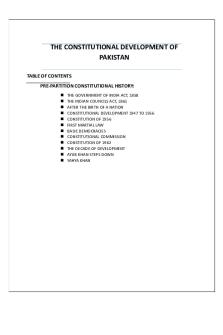
Constitutional History of pakistan
- 16 Pages
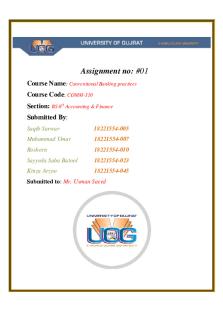
25 Banks of PAKISTAN
- 25 Pages
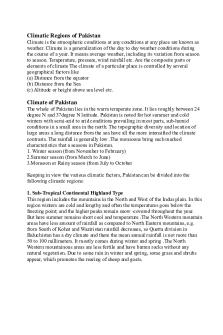
Climatic Regions of Pakistan
- 2 Pages
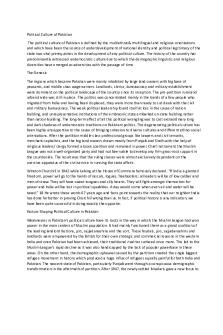
Political culture of Pakistan
- 11 Pages
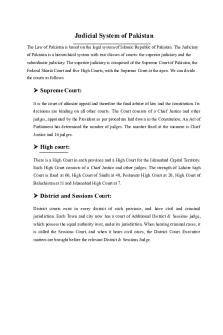
Judicial System of Pakistan
- 2 Pages

Major Substances of Abuse
- 6 Pages

Types of Major Accounts
- 5 Pages

Chronology of major events
- 2 Pages

Major Types of Socialization
- 6 Pages
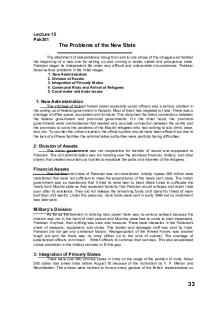
01 Early Problems of Pakistan
- 2 Pages
Popular Institutions
- Tinajero National High School - Annex
- Politeknik Caltex Riau
- Yokohama City University
- SGT University
- University of Al-Qadisiyah
- Divine Word College of Vigan
- Techniek College Rotterdam
- Universidade de Santiago
- Universiti Teknologi MARA Cawangan Johor Kampus Pasir Gudang
- Poltekkes Kemenkes Yogyakarta
- Baguio City National High School
- Colegio san marcos
- preparatoria uno
- Centro de Bachillerato Tecnológico Industrial y de Servicios No. 107
- Dalian Maritime University
- Quang Trung Secondary School
- Colegio Tecnológico en Informática
- Corporación Regional de Educación Superior
- Grupo CEDVA
- Dar Al Uloom University
- Centro de Estudios Preuniversitarios de la Universidad Nacional de Ingeniería
- 上智大学
- Aakash International School, Nuna Majara
- San Felipe Neri Catholic School
- Kang Chiao International School - New Taipei City
- Misamis Occidental National High School
- Institución Educativa Escuela Normal Juan Ladrilleros
- Kolehiyo ng Pantukan
- Batanes State College
- Instituto Continental
- Sekolah Menengah Kejuruan Kesehatan Kaltara (Tarakan)
- Colegio de La Inmaculada Concepcion - Cebu



